Vahid Mirjalili
GmNet: Revisiting Gating Mechanisms From A Frequency View
Mar 28, 2025Abstract:Gating mechanisms have emerged as an effective strategy integrated into model designs beyond recurrent neural networks for addressing long-range dependency problems. In a broad understanding, it provides adaptive control over the information flow while maintaining computational efficiency. However, there is a lack of theoretical analysis on how the gating mechanism works in neural networks. In this paper, inspired by the {convolution theorem}, we systematically explore the effect of gating mechanisms on the training dynamics of neural networks from a frequency perspective. We investigate the interact between the element-wise product and activation functions in managing the responses to different frequency components. Leveraging these insights, we propose a Gating Mechanism Network (GmNet), a lightweight model designed to efficiently utilize the information of various frequency components. It minimizes the low-frequency bias present in existing lightweight models. GmNet achieves impressive performance in terms of both effectiveness and efficiency in the image classification task.
PrivacyNet: Semi-Adversarial Networks for Multi-attribute Face Privacy
Feb 14, 2020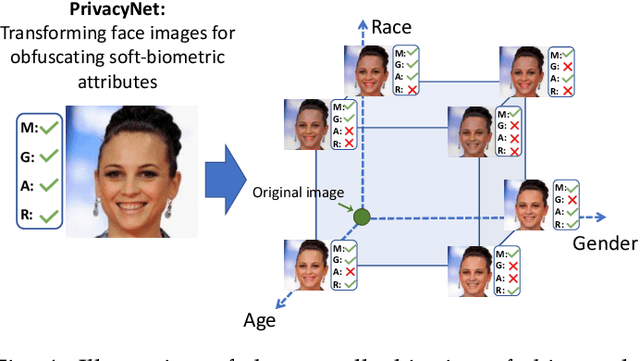

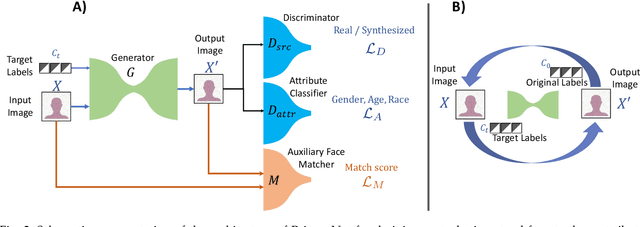

Abstract:Recent research has established the possibility of deducing soft-biometric attributes such as age, gender and race from an individual's face image with high accuracy. However, this raises privacy concerns, especially when face images collected for biometric recognition purposes are used for attribute analysis without the person's consent. To address this problem, we develop a technique for imparting soft biometric privacy to face images via an image perturbation methodology. The image perturbation is undertaken using a GAN-based Semi-Adversarial Network (SAN) - referred to as PrivacyNet - that modifies an input face image such that it can be used by a face matcher for matching purposes but cannot be reliably used by an attribute classifier. Further, PrivacyNet allows a person to choose specific attributes that have to be obfuscated in the input face images (e.g., age and race), while allowing for other types of attributes to be extracted (e.g., gender). Extensive experiments using multiple face matchers, multiple age/gender/race classifiers, and multiple face datasets demonstrate the generalizability of the proposed multi-attribute privacy enhancing method across multiple face and attribute classifiers.
Some Research Problems in Biometrics: The Future Beckons
May 12, 2019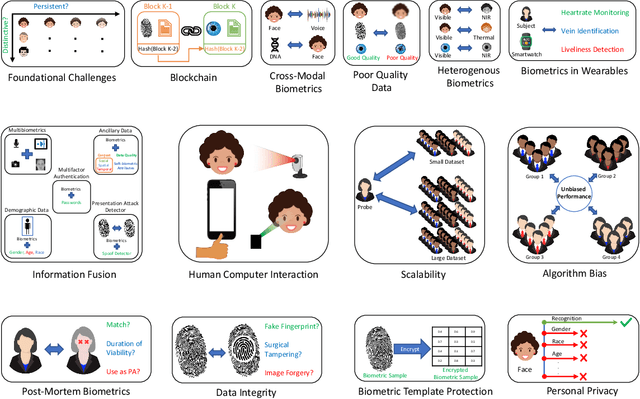

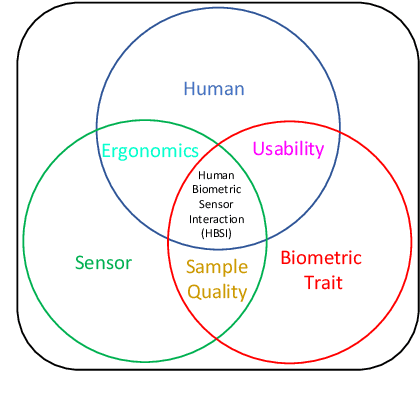
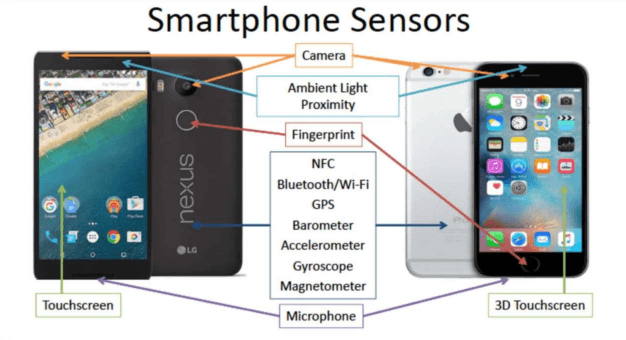
Abstract:The need for reliably determining the identity of a person is critical in a number of different domains ranging from personal smartphones to border security; from autonomous vehicles to e-voting; from tracking child vaccinations to preventing human trafficking; from crime scene investigation to personalization of customer service. Biometrics, which entails the use of biological attributes such as face, fingerprints and voice for recognizing a person, is being increasingly used in several such applications. While biometric technology has made rapid strides over the past decade, there are several fundamental issues that are yet to be satisfactorily resolved. In this article, we will discuss some of these issues and enumerate some of the exciting challenges in this field.
FlowSAN: Privacy-enhancing Semi-Adversarial Networks to Confound Arbitrary Face-based Gender Classifiers
May 03, 2019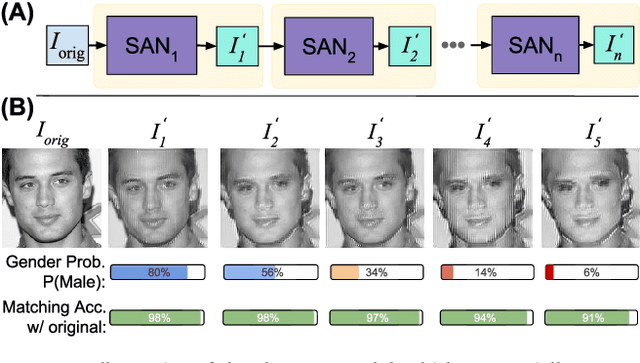

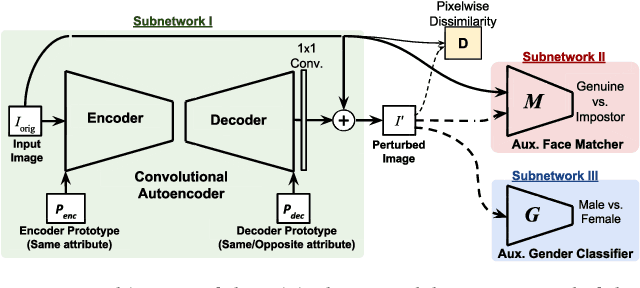
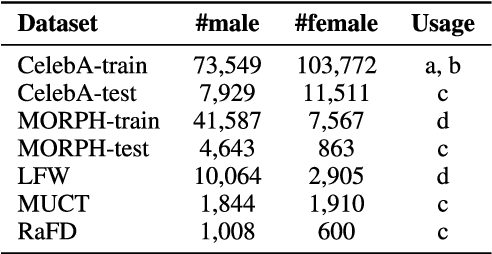
Abstract:Privacy concerns in the modern digital age have prompted researchers to develop techniques that allow users to selectively suppress certain information in collected data while allowing for other information to be extracted. In this regard, Semi-Adversarial Networks (SAN) have recently emerged as a method for imparting soft-biometric privacy to face images. SAN enables modifications of input face images so that the resulting face images can still be reliably used by arbitrary conventional face matchers for recognition purposes, while attribute classifiers, such as gender classifiers, are confounded. However, the generalizability of SANs across arbitrary gender classifiers has remained an open concern. In this work, we propose a new method, FlowSAN, for allowing SANs to generalize to multiple unseen gender classifiers. We propose combining a diverse set of SAN models to compensate each other's weaknesses, thereby, forming a robust model with improved generalization capability. Extensive experiments using different unseen gender classifiers and face matchers demonstrate the efficacy of the proposed paradigm in imparting gender privacy to face images.
ASD-DiagNet: A hybrid learning approach for detection of Autism Spectrum Disorder using fMRI data
Apr 16, 2019



Abstract:Mental disorders such as Autism Spectrum Disorders (ASD) are heterogeneous disorders that are notoriously difficult to diagnose, especially in children. The current psychiatric diagnostic process is based purely on the behavioural observation of symptomology (DSM-5/ICD-10) and may be prone to over-prescribing of drugs due to misdiagnosis. In order to move the field towards more quantitative fashion, we need advanced and scalable machine learning infrastructure that will allow us to identify reliable biomarkers of mental health disorders. In this paper, we propose a framework called ASD-DiagNet for classifying subjects with ASD from healthy subjects by using only fMRI data. We designed and implemented a joint learning procedure using an autoencoder and a single layer perceptron which results in improved quality of extracted features and optimized parameters for the model. Further, we designed and implemented a data augmentation strategy, based on linear interpolation on available feature vectors, that allows us to produce synthetic datasets needed for training of machine learning models. The proposed approach is evaluated on a public dataset provided by Autism Brain Imaging Data Exchange including 1035 subjects coming from 17 different brain imaging centers. Our machine learning model outperforms other state of the art methods from 13 imaging centers with increase in classification accuracy up to 20% with maximum accuracy of 80%. The machine learning technique presented in this paper, in addition to yielding better quality, gives enormous advantages in terms of execution time (40 minutes vs. 6 hours on other methods). The implemented code is available as GPL license on GitHub portal of our lab (https://github.com/pcdslab/ASD-DiagNet).
Consistent Rank Logits for Ordinal Regression with Convolutional Neural Networks
Jan 24, 2019



Abstract:While extraordinary progress has been made towards developing neural network architectures for classification tasks, commonly used loss functions such as the multi-category cross entropy loss are inadequate for ranking and ordinal regression problems. To address this issue, approaches have been developed that transform ordinal target variables series of binary classification tasks, resulting in robust ranking algorithms with good generalization performance. However, to model ordinal information appropriately, ideally, a rank-monotonic prediction function is required such that confidence scores are ordered and consistent. We propose a new framework (Consistent Rank Logits, CORAL) with theoretical guarantees for rank-monotonicity and consistent confidence scores. Through parameter sharing, our framework benefits from low training complexity and can easily be implemented to extend common convolutional neural network classifiers for ordinal regression tasks. Furthermore, our empirical results support the proposed theory and show a substantial improvement compared to the current state-of-the-art ordinal regression method for age prediction from face images.
Spoofing PRNU Patterns of Iris Sensors while Preserving Iris Recognition
Aug 31, 2018



Abstract:The principle of Photo Response Non-Uniformity (PRNU) is used to link an image with its source, i.e., the sensor that produced it. In this work, we investigate if it is possible to modify an iris image acquired using one sensor in order to spoof the PRNU noise pattern of a different sensor. In this regard, we develop an image perturbation routine that iteratively modifies blocks of pixels in the original iris image such that its PRNU pattern approaches that of a target sensor. Experiments indicate the efficacy of the proposed perturbation method in spoofing PRNU patterns present in an iris image whilst still retaining its biometric content.
Gender Privacy: An Ensemble of Semi Adversarial Networks for Confounding Arbitrary Gender Classifiers
Jul 31, 2018



Abstract:Recent research has proposed the use of Semi Adversarial Networks (SAN) for imparting privacy to face images. SANs are convolutional autoencoders that perturb face images such that the perturbed images cannot be reliably used by an attribute classifier (e.g., a gender classifier) but can still be used by a face matcher for matching purposes. However, the generalizability of SANs across multiple arbitrary gender classifiers has not been demonstrated in the literature. In this work, we tackle the generalization issue by designing an ensemble SAN model that generates a diverse set of perturbed outputs for a given input face image. This is accomplished by enforcing diversity among the individual models in the ensemble through the use of different data augmentation techniques. The goal is to ensure that at least one of the perturbed output faces will confound an arbitrary, previously unseen gender classifier. Extensive experiments using different unseen gender classifiers and face matchers are performed to demonstrate the efficacy of the proposed paradigm in imparting gender privacy to face images.
Semi-Adversarial Networks: Convolutional Autoencoders for Imparting Privacy to Face Images
May 03, 2018



Abstract:In this paper, we design and evaluate a convolutional autoencoder that perturbs an input face image to impart privacy to a subject. Specifically, the proposed autoencoder transforms an input face image such that the transformed image can be successfully used for face recognition but not for gender classification. In order to train this autoencoder, we propose a novel training scheme, referred to as semi-adversarial training in this work. The training is facilitated by attaching a semi-adversarial module consisting of a pseudo gender classifier and a pseudo face matcher to the autoencoder. The objective function utilized for training this network has three terms: one to ensure that the perturbed image is a realistic face image; another to ensure that the gender attributes of the face are confounded; and a third to ensure that biometric recognition performance due to the perturbed image is not impacted. Extensive experiments confirm the efficacy of the proposed architecture in extending gender privacy to face images.
 Add to Chrome
Add to Chrome Add to Firefox
Add to Firefox Add to Edge
Add to Edge